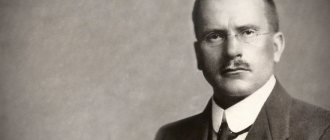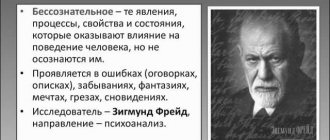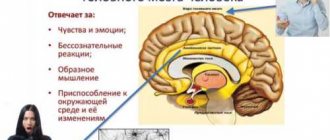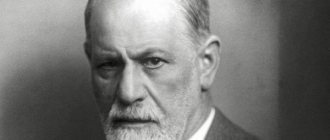The unconscious is all mental processes, phenomena that are not consciously recognized by the subject and are not controlled by the conscious part of the psyche. The term “unconscious” is used by specialists in various fields of science - in psychology and psychoanalysis, psychiatry, philosophy, and jurisprudence. The concepts of “conscious” and “unconscious” are interpreted as antonyms, as well as different levels of the structure of the human psyche.
What is this in psychology?
The unconscious is a set of various mental states and processes that are carried out under the influence of certain phenomena of the surrounding reality and the impact of which the individual is not aware of.
The reality reflected by a person is combined with his experiences.
An important feature of this mental process is that it is impossible to control it.
The human unconscious is the subject of study in such fields of knowledge as psychology and psychoanalysis.
Historical summary
The first mentions of the area of the unconscious, the processes that it contains, can be found in the works of Plato, namely in the doctrine of cognition-memory. This concept underwent fundamental changes after the publication of work on the study of consciousness by R. Descartes. He believed that beyond consciousness there could only be physiological, but not mental, activity of the brain.
The concept of the unconscious was first formulated by G. Leibniz in his work “Monadology”, published in 1720. He argued that it is precisely this that is the lowest manifestation of mental activity. In his opinion, this area is located on the border of conscious ideas.
An attempt to make an accurate materialistic description was made by D. Hartley. He combined the area of the unconscious with the work of the central nervous system.
The incentive for active study of the area of the unconscious, the mental processes that it contains, appeared after many successes in the study and development of psychopathology. To work with patients, specific techniques were used, with the help of which scientists influenced the area of the unconscious. A striking example is hypnosis.
Correlation with consciousness
In general, mental phenomena are divided into two groups:
- conscious , that is, those that a person is directly aware of,
- unconscious , which a person is not aware of.
It is the totality of these processes that constitute the psyche. Together they help a person adapt to the outside world.
At the same time, the area of influence of consciousness includes the management of complex forms of behavior that require the control and attention of the individual.
Despite this, it should be noted that most behavioral acts are committed precisely at the unconscious level.
Levels
The unconscious in a person’s personality has several levels:
- higher;
- average;
- inferior;
- personal;
- collective.
Psychology still does not give a definitive answer as to what other components the structure of the unconscious may include. Its components may differ in different methodological approaches. In addition, there are no reliable, absolutely reliable methods for studying this part of the human psyche.
The differentiation of the levels of the unconscious sphere that modern psychologists use reflects qualitative characteristics.
Structure
The structure of this mental phenomenon includes:
- Unconscious actions. This includes gestures, facial expressions, vegetative reactions (trembling hands, redness or paleness of the face, etc.)
- Unconscious attitudes . They represent readiness for certain reactions or actions.
- Unconscious automatisms .
They are understood as actions that are performed without direct participation. This includes breathing, walking, swimming, etc. - Supraconscious processes . These are some sudden insights, which include inspiration, intuition, wisdom, etc.
First signs
The following are signs that precede syncope:
- causeless anxiety, weakness, incessant yawning, heavy breathing;
- pale skin, sweating;
- headaches that bring a pressing or squeezing sensation, noise in the ears (ringing in the ears may be present), dizziness, hearing problems, suffocation;
- adrenaline rush, accompanied by heat at the end of the fingers;
- darkening before the eyes;
- tonic convulsions;
- a sharp increase or decrease in pressure, heart rate increases;
- nausea, vomiting, sour taste in the mouth.
Fainting is characterized by the presence of the following manifestations:
- the muscles are relaxed and the body is motionless;
- breathing slows down;
- blood pressure decreases;
- in case of deep fainting, the occurrence of convulsions and incontinence cannot be excluded;
- Pupils dilate, in the presence of serious pathologies, there is no reaction to light.
Kinds
The classification is as follows:
- Congenital . As the name suggests, we have it initially, from birth. It is divided into individual (attraction, instincts) and collective. Below we will look at the archetypes of the collective unconscious, who discovered them and what their essence is.
- Social . This includes attitudes, values and beliefs that appear and are formed in us during our upbringing, under the influence of others, primarily family.
- Repressed . It is formed under the influence of our censorship, when feelings and desires unacceptable to a person are transferred from consciousness to this area.
- Preconscious . This includes feelings and thoughts that were previously conscious, but have now lost their relevance and have been transferred to this sphere.
How to independently develop emotional intelligence? Read about it here.
Psychological theories and schools
The concept of the unconscious in psychology occupied a central place in most schools, finding both supporters (the unconscious exists and this fact must be taken into account) and opponents (there is no unconscious). This sequence of views can be reflected in the form of a table with a brief overview of the interpretation of the unconscious by the main psychological schools.
| School | Key concept | Key concept function | Therapeutic effect | |
| Unconscious | Other | |||
| Freud | Central role | — | The unconscious is a source of energy, a collection of repressed impulses and a generator of symptomatic reactions. | It is necessary to introduce subconscious processes into consciousness in order to change the Id (It) and focus on the Ego (I). |
| cabin boy | Central role | — | The unconscious is the guiding basis of the psyche, the repository of personal memories and imaginative structures of “archetypes”. | There must be a process of individuation that involves the development of a dynamic relationship between the ego and the self. This is the process of spiritual growth of the individual due to the “manifestation” of the deep traits of the subconscious as a result of their assimilation by consciousness. The process of individuation, according to Jung, is driven by a hidden tendency emanating from the spiritual center of human individuation. |
| Behaviorism | Negation | Behavior | Behavior is the basis of personal experience and the source of anticipation and control of activity. | It is necessary to form new conditioned reflexes in order to achieve more adequate or desired behavior. |
| Humanistic | Neutral role | Self-realization | Self-realization is the driving principle of activity and a means of achieving personal integrity. | It is necessary to form the potential of the individual and provide her with the conditions for development, strengthen her innate abilities |
| Cognitive | Neutral role | Cognition | Cognition is the main conductor of a person’s belief system, which determines his experience | It is necessary to change a person’s destructive attitudes and views, to explore his views. |
| Erickson | Central role | — | The unconscious is the repository of human experience, the source of his capabilities and the elimination of symptoms. | It is necessary to activate a person’s unconscious energy to solve an internal problem. |
Unconscious human actions: examples
Such unconscious actions, as we have already said, include processes that occur unconsciously .
For example, in order to breathe, you do not need to control this process or say to yourself “inhale-exhale.” The person just does it and doesn’t even notice. The same thing, for example, with walking.
As an example, we can also cite some of the skills that we acquire. For example, driving a car or swimming . First, a person learns and understands these processes.
Then, as a result of many hours of practice, he no longer thinks about what movements he needs to make to swim or park.
Eros
Eros is a sexual instinct, it is a manifestation of libido. A person, not being in the herd, cannot fully realize all his sexual aspirations. He unwittingly has to suppress them, limiting himself. In a favorable situation, sexual energy will be directed towards creation, creativity, science or political activity.
In other words, in any direction that requires a powerful investment of strength and manifestation of oneself. Sigmund Freud called this displacement of the sexual instinct into another sphere the term “sublimation.”
Research methods
Methods of analysis or research were developed by S. Freud and his supporters, these are:
- free association method,
- dream analysis method.
The first method is based on the psychoanalyst deciphering a continuous stream of words reproduced by the patient . He looks for a pattern in them and, on its basis, makes a conclusion about the possible causes of a person’s mental state.
An example of this method is an associative experiment. The psychoanalyst names the word, and the patient must respond with the first thing that comes to his mind.
Sooner or later, the patient will begin to manifest words that are precisely connected with his hidden experiences.
Dream analysis is also carried out by identifying a person’s experiences. It is based on the theory that in dreams the control of consciousness is much weaker, and therefore the individual’s real anxieties and desires can emerge in dreams.
Foundation concept
Conflicts arise between the conscious and unconscious parts of a person, resulting in neuroses and mental disorders that interfere with normal human life. This became the main idea of Freud's concept of the unconscious. Painful and shameful experiences are repressed into the superego and manifest themselves in the form of unpleasant symptoms somewhere on the border between somatic and mental manifestations.
Accordingly, in order to balance these conflicts, it is necessary to establish a balance between the Ego and the Super-Ego, which is what psychoanalysts do. During the patient's long story about his thoughts and feelings, with the help of a specialist, he gradually comes to the true cause of his neurotic behavior. “According to grandfather Freud,” such a reason, of course, is suppressed sexual desires. According to modern psychoanalysts, there can be a large number of reasons, and for each person they are individual.
Job: technicians
There are various techniques for working with the unconscious that will help you understand your hidden feelings and desires .
Let's look at some of them.
- Dream Catcher . This technique is based on the dream analysis method. Its difference is that you need to write down your dream immediately after waking up, and try to do it in as much detail as possible. To do this, you can use a notepad, voice recorder or phone. Even if you wake up in the middle of the night, you need to record what you dreamed. The next day you should read/listen to what was recorded and try to understand what it might mean. As a rule, the message of the subconscious is presented in a dream in a direct way, so there are no difficulties with decoding. Please note that the key moment of sleep can be both your feelings and desires, as well as anxieties, fears, and experiences.
- A letter to myself. A very easy technique to perform.
You need to sit down and write yourself a letter. It should ask questions that concern you, turning to yourself. Ask what you feel, what worries you. Then immediately start writing a response letter. And here it is very important not to control yourself, just write down all the thoughts that arise. It is the response letter that will become a manifestation of your unconscious. - Inducing a trance. Take a comfortable position and start scanning different parts of the body. What does the right hand, sacrum, neck, back of the head, left heel, etc. feel? Gradually you will be immersed in a trance state. You can also induce a trance by repeating the same phrase mentally over and over again, like a kind of mantra. You can turn on music with the same rhythm. Once you reach this state, the unconscious itself will begin to give you clues. You will hear his voice and reveal your hidden feelings.
Issues
Scientists know for sure that the unconscious exists and influences human life. Processes occurring in the unconscious part of the psyche make you experience tension. It will be possible to reduce its intensity only if you transfer information from the unconscious layer to the conscious one. This can be prevented by protective mechanisms - resistance, repression. Customer service specialists are not always able to quickly overcome them.
The problem can be resolved through the use of techniques that make it possible to minimize the control of consciousness - hypnosis, projective techniques.
Irina Sherbul
Criticism of the scientific community
Many eminent scientists of the 20th century expressed their doubts about Freud's ideas. Let us highlight the main ones:
| Scientist | Criticism |
| Fritz Perls | The creator of Gestalt therapy, in his author’s works, seems to be conducting a constant critical dialogue with Freud, challenging all sorts of aspects of psychoanalysis [1]. |
| Erich Fromm | He accused him of being too “bourgeois” and adapting classical psychoanalysis to the needs of the time [2]. |
| Albert Ellis | Having succumbed to the stronger influence of the works of Karen Horney and Erich Fromm, he leaves the ranks of ardent supporters of the theory of psychoanalysis and refutes many of its fundamental principles [3]. |
| Karl Kraus | The literary critic reproached F. for creating almost a new secular religion, where the main figure of worship is the psychoanalyst himself. |
| Karl Popper | Scientist known for creating the falsifiability criterion. While studying F.’s works, he doubted the scientific nature of psychoanalysis and called the theory untrustworthy [4]. |
| Alfred Adler | One of the accomplices and potential successors of Freud’s “circle” repeatedly subjected Freud’s ideas to devastating criticism, which was the reason for their quarrel. |
| Carl Jung | The departure of Carl Jung himself from F.'s circle of associates turned out to be a stab in the back. The split occurred due to Jung’s passion for occult practices and rejection of F.’s idea of the supremacy of the sexual component in the human psyche [5]. |
| Hans Jurgen Eysenck | One of the leaders of the biological direction in psychology, the creator of the factor theory of personality, the author of a popular intelligence test, wrote in his book: “Instead of experimentally verified conclusions from clearly formulated hypotheses, we find only anecdotal evidence collected rather randomly from individual case histories.” [13]. |
The reason for this is most likely not only the shocking ideas of the psychologist, which shocked the scientific community, but also a deep analysis of the work of the “discoverer”. Moreover, no one had dared to speak so openly about such intimate aspects of a person’s life before.
Sex is the end in itself of all things! Z. Freud
Unconscious automatisms
The processes included in the subclass of unconscious automatisms are of a dual nature:
- never realized before (fundamentally not realized),
- once conscious, but at the moment occurring automatically (skills).
Examples of fundamentally unconscious ones: a child’s sucking movements, blinking, eye convergence, grasping objects, walking and much more. Examples of skills: playing a musical instrument, writing, speaking a foreign language, and an endless number of other skills.
It is worth noting that psychologists distinguish in the structure of consciousness:
- focus of consciousness (the most important thing at the current moment in time),
- periphery of consciousness (weak control by consciousness is exercised),
— the boundary of consciousness (the processes located here can either leave the field of human consciousness or enter it),
- unconscious.
Developed skills usually “balance” on the border of consciousness. If a person begins to make a lot of mistakes (when tired, for example, or when the activity becomes more complicated), then the skill again falls into the field of consciousness, to its periphery or even into focus. The skill is controlled, improved, and then returns again to the border of consciousness. This is what distinguishes skills from fundamentally unconscious processes, in that they “wander.”
Various examples of automatisms:
- when reading any text fluently, we do not think about the outline and meaning of individual letters, but “immediately” perceive the meaning of what we read,
- a radio operator working with Morse code, perceiving the sound of short and long signals, completely freely translates them into a logical combination of letters and words,
— entering a dark room, the hand “itself” reaches for the switch.
Modern look
Modern cognitive science has made great progress. The main subject of her research is consciousness, but without studying the unconscious, the study of consciousness is not possible. It should be noted that this issue is of interdisciplinary significance and is studied from the perspective of neurophysiology, artificial intelligence research, linguistics, anthropology, and psychology. The study of the unconscious made it possible to describe the mechanism and origin of such processes as:
- Perception
- Memory
- Creation
Russian scientists studying the problems of the unconscious: N.T. Abramova, N.S. Avtonomova, D.I. Dubrovsky, V.A. Lecturer's Creativity in the context of the unconscious was studied by I.A. Beskovaya, I.A. Gerasimova. In foreign studies, the problems of the unconscious are represented by the philosophical works of D. Dennett, D. Fodor, D. Searle. And we undoubtedly owe a lot in modern science and art to this discovery. A discovery that served as the basis for a new understanding of human thinking and existence.
Mistakes of everyday life
Examples are slips of the tongue, slips of the tongue, forgetting intentions, unexplained loss of things. All these manifestations of B. are material for analyzing the causes of symptoms.
Causes. Typically these are unresolved problems or repressed desires.
It’s rare that slips of the tongue can be called anything other than “slips of the tongue.” These are reservations in their purest form: I wanted to say “open”, I said “close”. Most slips of the tongue are impaired speech. One component of the slip is what he wanted to say consciously, and the other is what he said unconsciously. Example: it said, “I’ll give it up?”, I wanted to say, “I’ll give it to myself?”
Here is an example from Freud’s own life: an exquisite and expensive pencil was lying on his desk. You need to look for lost things (according to F.) in the following way: “Who gave the pencil? What happened to the donor recently?
So, Freud recalled that the other day he had a quarrel with his wife. And before I had time to remember this, the pencil was already lying in its original place, in front of the scientist’s nose.”
Now you have a clear understanding of the problem of the unconscious in psychoanalysis. It's time to go deeper.
Unconscious contents of the psyche
The category of the unconscious includes a variety of mental processes that have different names within the framework of different theoretical concepts. First of all, these are mental processes associated with automated behavior controlled under the cortical structures of the brain. This includes numerous signals coming from internal organs, joints, muscle spindles, skin surface, receptors throughout the body, the insignificant strength of irritation of which does not allow them to become a priority and be recognized. P.V. Simonov gives p uc . ll . l .
m. Frank.
Dwelling (Science. 1998. this group of mental phenomena May/June). the name is preconscious.
251
Patients who lose consciousness during surgery often report later that at that moment they heard doctors talking about their condition, felt the pressure of the needle with which drugs were injected, but could not move or communicate with others. Their memory was capable of retaining information about these events.
The unconscious also includes those phenomena that were once conscious and can be conscious again under certain conditions, but are currently not included in the sphere of consciousness. Indeed, every person at different moments in life is aware of a wide variety of information. Having ceased to be a priority, it does not disappear forever, but persists and waits in the wings. Moreover, it can participate in regulating human behavior without entering the realm of awareness. These unconscious contents are called preconscious
within the framework of the psychoanalytic concept and
the subconscious
according to the classification of P.V. Simonova.
And finally, the unconscious refers to the unconscious -
central concept of psychoanalytic theory. By definition, the unconscious is that part of the psyche whose contents cannot become conscious without the use of special (psychoanalytic) techniques. It includes instinctual desires, emotions and repressed thoughts (Figure 11.2).
The structure of the unconscious is absent in the concept of P.V. Simonov, but there is another structure in it - superconsciousness, or intuition. It, unlike the subconscious, devoid of creativity, is a source of new hypotheses and discoveries.
The division of the psyche into consciousness and unconscious processes raises the question of how information is translated into the category of conscious or unconscious. If for automated behavior and preconsciousness the reason for being outside consciousness may be the lack of priority or weakness of impulses (Libet, 1991) (this mechanism will be discussed in Chapter 12), then in the case of the unconscious, from the point of view of psychoanalysis, consciousness has special reasons not to allow its contents to become conscious.
Lack of awareness is fixable
For everyone who recognizes themselves in the description of an unconscious person, there is good news: it can be fixed!
We all go through a phase of unawareness during childhood. The child does not think in terms of long-term goals; he is not able to understand the true reasons and meanings of his actions.
While consciousness has not yet developed in the little man, his survival is ensured by his parents.
An adult cannot afford to remain unconscious. However, each of us is, to one degree or another, susceptible to unconscious states. You just need to work through them without reproaching yourself for wrong actions or thoughts.
Developing mindfulness is hard work. But it always pays off by achieving higher tastes in life.







